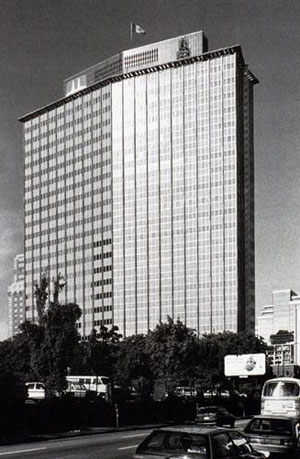Built Heritage of the Modern Era
Today's broader, more inclusive definition of heritage has
allowed built heritage of the Modern Era to be recognized for its
historic and cultural value. Built heritage of the Modern Era
encompasses all types of constructions between 1930 and the
mid-1970s, an era marked by a wide-spread faith in a better future
independent of the past, extraordinary changes in lifestyle, and
unprecedented growth in Canada. However, built heritage of the
Modern Era is often undervalued by the general public. The heritage
of the Modern Era is underrepresented in the heritage sector, with
only 3% of our National Historic Sites of Canada and less than a
quarter of our designated Federal Heritage Buildings post-dating
1930. Fortunately, in recent years the study of this rich era of
Canadian architectural history has increased amongst professionals
and scholars.
Since 1997, the Historic Sites and Monuments Board have had
specific criteria for the designation of built heritage of the
Modern Era. The building, ensemble or site must be an outstanding
illustration of the changing social, political and/or economic
conditions, involve rapid technological advances or represent new
expressions and/or responses to unique functional demands of the
era. Also, a site will be considered if it represents a precedent
that had a significant impact on subsequent construction. Built
heritage of the Modern Era presents a unique challenge in
conservation as buildings were often planned for obsolescence. Many
examples of built heritage of the Modern Era in Canada have been
adapted or altered over the course of their life and remain in use.
Hence, when considering constructions from this period, the idea of
material authenticity is approached differently. To be considered
of national significance, a proposed site must be in a condition
that respects the integrity of its original design, materials,
workmanship, function and/or setting, insofar as each of these was
an important part of its overall intention and present character,
rather than strictly materially intact.
 Designated built heritage of the Modern Era is
surprisingly varied. Many sites are concerned with the growing
middles classes, such as the Binning Residence National Historic Site of
Canada in West Vancouver, British Columbia. The house is a very
early example of Modern residential design, encapsulating the
post-and-beam West Coast Style, and became a model for later
construction. Built in 1941, during the Second World War, the house
combined a Modern approach to form and function with economy and
efficiency of construction by using local materials and up-to-date
building technologies, so as to be affordable for the average
family.
Designated built heritage of the Modern Era is
surprisingly varied. Many sites are concerned with the growing
middles classes, such as the Binning Residence National Historic Site of
Canada in West Vancouver, British Columbia. The house is a very
early example of Modern residential design, encapsulating the
post-and-beam West Coast Style, and became a model for later
construction. Built in 1941, during the Second World War, the house
combined a Modern approach to form and function with economy and
efficiency of construction by using local materials and up-to-date
building technologies, so as to be affordable for the average
family.
 Other designated buildings include resources for
previously neglected groups, such as the much needed facilities of
the Canadian North. The Yellowknife Post Office was built in 1956 as
Yellowknife dramatically expanded. The Post Office was a focal
point of the community, linking to the outside world and serving
businesses, politicians and individuals. The Post Office building
is a modest rectangular two-storey frame building with a flat roof.
In stark contrast architecturally, its contemporary, the former B.C. Hydro Building, designed by the
engineer Otto Safir, is a 21-storey, distinctively-tapered,
lozenge-shaped tower. The tower is an early example of glass
curtain-wall construction, an important twentieth-century
innovation. It is representative of post-war economic expansion,
which placed an emphasis on large infrastructure and resource
extraction initiatives.
Other designated buildings include resources for
previously neglected groups, such as the much needed facilities of
the Canadian North. The Yellowknife Post Office was built in 1956 as
Yellowknife dramatically expanded. The Post Office was a focal
point of the community, linking to the outside world and serving
businesses, politicians and individuals. The Post Office building
is a modest rectangular two-storey frame building with a flat roof.
In stark contrast architecturally, its contemporary, the former B.C. Hydro Building, designed by the
engineer Otto Safir, is a 21-storey, distinctively-tapered,
lozenge-shaped tower. The tower is an early example of glass
curtain-wall construction, an important twentieth-century
innovation. It is representative of post-war economic expansion,
which placed an emphasis on large infrastructure and resource
extraction initiatives.
Many sites of the Modern era are more vulnerable than their
predecessors; the materials and methods of construction were often
less durable and in some cases experimental or not designed for
longevity. This makes conservation technically challenging and of
pressing importance. But, through increased public
initiatives and awareness of the unique values of built heritage of
the Modern Era, the architectural production of this distinctive
period of Canadian history can be protected.